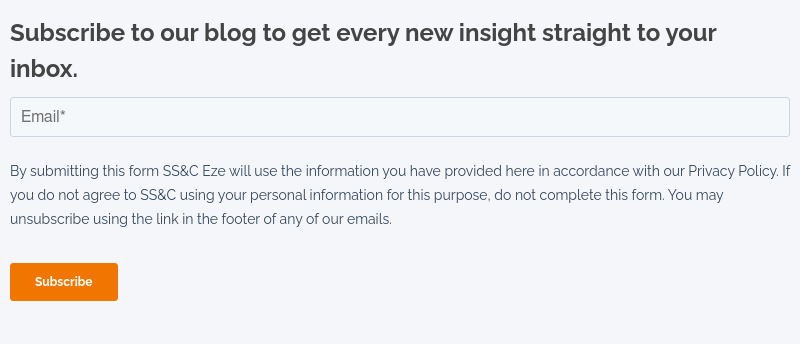Market Changes Put Focus on the Capabilities of an Order Management System
In its 2025 Investment Management Outlook survey, research firm Deloitte notes that investment firms are “Navigating fast-paced change, elevated risk, and outsized opportunity.” The report says that in 2025, critical priorities for investment firms will be growing revenue, streamlining operations, and managing risk.
The good news is that today’s technology is helping firms to navigate these changes and secure new opportunities. One such technology is the Order Management System (OMS).
With features that enable you to implement your investment ideas quickly and accurately, the OMS helps you create operational efficiencies, capture more opportunities, and enhance your bottom line.
To fully understand the scope of the OMS’ capabilities, this blog reviews the features, functionality, and benefits a modern OMS brings to an investment firm’s operations – and its ultimate success.

Order Management: The Heart of an Investment Firm’s Operation
Before diving into the qualities of an order management system, it's essential to understand the importance of the order management process in an investment firm's operations.
Order management is the bridge between investment strategy and execution. It transforms a portfolio manager's investment ideas into actionable trades.
At its core, order management involves handling buy and sell orders for financial securities such as stocks, bonds, options, futures, and other investment products. This function ensures that these orders are executed efficiently and in strict compliance with regulatory requirements while maintaining alignment with the firm's overarching strategies.
What is an Order Management System (OMS)?
What is an OMS? Today, as firms strive to maximize operational alpha, many turn to their OMS. The right OMS can provide a fast, accurate, and integrated way to help you focus on alpha-generating activities and turn investment ideas into reality.
A modern OMS also offers capabilities like portfolio modeling, the ability to view P&L and exposures, order routing, decision support, and analytics functionality. Together, these features help your firm meet the challenges of today’s markets.
While early OMSs focused on equities, today's OMS supports your firm’s ever-expanding array of asset classes.
As the hub of your investment activity, your OMS must be configurable and flexible. If the trade generation process is clunky and inefficient, it wastes valuable time and puts you at a higher risk for errors and missed opportunities.
Finally, your OMS platform must be able to grow and scale with you as your needs change. Without that scalability, you may be forced to pay for expensive upgrades, custom enhancements, or system replacements, making the total cost of ownership of your OMS much higher than you originally budgeted for.
Understanding the Capabilities of an Order Management System (OMS)
A well-designed OMS empowers firms to make smarter decisions, reduces operational risks, and provides the scalability needed to grow their trading activities seamlessly.
To realize these benefits, ensure that the OMS you choose has these critical functions:
Order Creation and Management
Accurate order creation is essential for successful trade execution, and an OMS ensures that each order is fully equipped with the necessary data and identification for placement. A robust OMS also provides asset class-specific workflows and enables streamlined order allocation based on fund groups displayed in a single view, allowing you to generate and allocate orders with maximum efficiency.
Rules-Based Order Routing
An OMS should deliver customizable, automated solutions that elevate daily trading operations.
For example, a configurable OMS can auto-route low-touch orders based on pre-defined rules, freeing your team to focus on high-touch trades.
Once an order is created, the OMS routes less-sophisticated trades to the optimal execution venue, such as exchanges or brokers, using strategies based on liquidity, trading costs, and market conditions. This frees up trader time to work more complex trades in the Execution Management System (EMS).
Trade Allocation
After the trade is executed, the OMS automatically allocates it to the relevant client accounts based on predefined strategies or custom rules. Automating trade allocation improves efficiency and accuracy, ensuring that client portfolios are correctly updated without manual intervention.
Position and Portfolio Management
The OMS tracks current positions in real time, helping you see how individual trades affect your firm’s overall portfolio holdings, exposures, and risk. With this up-to-date view of portfolio performance and exposures (like sector, region, or currency), you are better able to make informed decisions quickly.
Compliance and Risk Management
The OMS conducts rigorous pre- and post-trade compliance checks to ensure every trade aligns with regulatory standards and internal policies, including restricted lists and position limits.
These checks proactively reduce the risk of compliance breaches, shielding your firm from potential penalties and reputational harm.
Trade Settlement and Reconciliation
The OMS seamlessly integrates with post-trade systems to swiftly and accurately complete the settlement process after each trade. It also reconciles trades with counterparties and custodians, ensuring alignment across parties, minimizing risk, and finalizing trades smoothly with minimal delays or errors.
Scalability and Flexibility
Today’s OMSs are designed to seamlessly scale with your firm’s growth, flex to evolving investment strategies, and stay ahead of regulatory shifts, all while supporting a diverse array of asset classes—from equities and fixed income to derivatives and alternative assets.
Connectivity with Other Systems
A good OMS integrates seamlessly with other essential systems like Portfolio Management Systems (PMSs), Execution Management Systems (EMSs), risk platforms, and market data feeds. This connectivity enables smooth data flow across platforms, minimizing manual input and errors while enhancing decision-making and risk management.
Dependable Service and Support
A next-generation OMS provider should deliver exceptional service that adapts as your firm grows and evolves. Their service teams are composed of seasoned professionals who understand the unique demands of the investment industry.
With this extensive experience, they grasp both the urgency and intricacies of front-office operations, ensuring you receive timely and effective support.
What are the Benefits of an OMS?
An order management system isn’t just a tool—it’s an essential part of your firm’s successful operations.
Let’s take a closer look at how the OMS brings value to your operations:
Increased Efficiency
Automating manual tasks through an OMS dramatically reduces processing times and optimizes workflows, giving your portfolio managers and traders more time to focus on what truly matters—generating alpha and driving performance.
Enhanced Accuracy
Manual order entry is often riddled with risks. By automating order placement and routing, an OMS minimizes human error, ensuring higher accuracy and reducing the chances of costly mis-trades.
Improved Risk Management
With real-time pre- and post-trade checks, an OMS helps you stay compliant with regulatory requirements while protecting your investments. This proactive risk management boosts both internal and investor confidence.
Greater Transparency
A centralized OMS provides complete visibility into all order activity, allowing you to track order flow effortlessly. This transparency not only streamlines performance attribution but also highlights opportunities for how your firm can improve.
Growing with the Needs of Your Firm
Modern OMS solutions are built to scale alongside your business, seamlessly adapting to growth and evolving trading strategies. Their flexibility also ensures smooth connectivity with various systems, tailoring perfectly to your unique operational ecosystem.
Next-Generation OMS Supporting Investment Managers’ Success in Today’s Markets
A next-generation OMS is critical in today’s changing markets. And when investment managers look for a modern solution, they choose SS&C’s OMS.
At SS&C, we have a demonstrated history of anticipating market needs and developing technical innovations to support them.
Our cross-asset OMS technology includes access to advanced automated trading tools through seamless connectivity to our EMS and enables quick and easy connections to vital third-party systems to create a complete investment ecosystem that can grow and expand as the needs of your firm change.
And with real-time integrated pre-, intra-, and post-trade compliance, the OMS ensures compliance is a consideration at each step of the process.
As part of our commitment to innovation, we recently revealed an upgraded OMS user interface. This update keeps pace with investment managers' evolving use of the platform, improving visual ergonomics, offering cleaner grids and blotters, and eliminating unused options.
This robust technology and ongoing innovation – combined with our outstanding service and support – enable you to meet today's market demands and prepare for whatever may lie ahead.
Learn More
To learn more about the next-generation OMS, trading technology trends, and selecting the right front-office solution for your firm, download your free copy of our Trading Technology Buyer's Guide.


